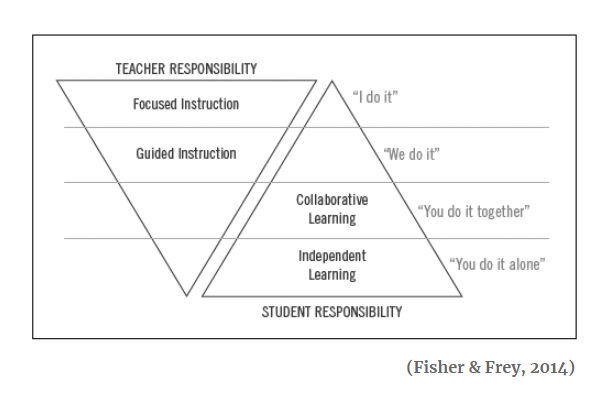Contributing Faculty
This module was produced by Dr. Tomeka Wilcher.
Essential Questions
-
What does it mean to scaffold instruction?
-
Why is scaffolding critical in student learning?
-
How can instructors scaffold instruction?
The gradual release of responsibility framework purposefully and gradually shifts the cognitive load from the teacher to the students. The teacher moves from modeling to guiding instruction to providing students with opportunities to collaborate before they engage in an independent learning experience. The framework is structured so that scaffolding can occur through steps that the instructor has put in place as well as through the activities and guided resources provided. The gradual release of responsibility consists of the following phases: focused instruction, guided instruction, collaborative learning, and independent learning.
Focused Instruction
During focused instruction, instructors are leading the learning process. They begin with the purpose and use modeling, think-alouds, and noticing to provide direct explanations of their cognitive strategies (Fisher & Frey, 2014). This part of the instructional framework goes beyond telling. Instructors model the skill or concept. The strategy of think-alouds allows students to hear them simplify complex ideas or concepts, analyze, problem-solve, and use critical thinking skills. With the strategy of noticing, instructors pay attention to students' understanding or confusion; this will determine next steps and what to teach or reteach.
Guided Instruction
Guided instruction occurs after focused instruction, within small groups. It involves instructors beginning the process of shifting the cognitive load to students through the use of questions, prompts, and cues. With the guidance of the instructor, students are applying and transferring the concept, skill,or strategy to a new situation. Questions are used to check for students' understanding, but they can also be used to "uncover errors and misconceptions" (Fisher & Frey, 2014, p. 41). Prompts are incorporated within the lesson to give hints as the instructor navigates students through the application of the skill, concept, or strategy. If prompts are not helpful, the instructor uses visual, verbal, gestural, and environmental cues to direct students to the answer. However, if students are still struggling after the cues, instructors can use direct explanations. There is a shift from guided instruction back to focused instruction: The purpose is re-established, and the instructor is modeling, using think-alouds, and monitoring students' understanding (Fisher & Frey, 2014). Guided instruction gives the instructor more insight on students' needs as well as on next steps in planning, teaching, and assessing.
Collaborative Learning
Collaborative learning should be an established part of the gradual release of responsibility (Fisher & Frey, 2014). This takes place after the instructor engages students in guided practice. Students are still working and learning in small groups; however, their responsibility has increased as they continue to apply and transfer their knowledge. Collaborative learning entails students working together and utilizing soft skills - communication, leadership, negotiation - to problem-solve, to think critically, and to analyze (Fisher & Frey, 2014). With students in collaborative groups, the teacher offers guided instruction to focus on the specific needs of students who may still show confusion. During collaborative learning, students experience positive interdependence, face-to-face interaction, individual and group accountability, interpersonal and small group skills, and group processing (Johnson, Johnson, & Smith, 1991; Fisher & Frey, 2014). Students are learning from each other as they become more confident in understanding the new concepts, information, strategies, and/or skills that were modeled during focused instruction and targeted during the guided practice.
Independent Learning
Independent learning is one of the many goals of the gradual release of responsibility framework. As the instructor moves students through the phases of gradual release, students are exposed to the strategies, thinking, and processes needed for transfer of skills. Independent learning is not about students working alone; it is about students thinking about their thinking. Because the instructor scaffolded the instructional process using gradual release, students have been exposed to the knowledge needed to apply skills, strategies, ideas, and content to new and unique situations (Fisher & Frey, 2014). Independent learning consists of metacognition. Students learn to ask the following questions: (1) What am I trying to accomplish? (2) What strategies am I using? (3) How well am I using the strategies? (4) What else could I do? Students also learn and practice self-regulation, whereby they incorporate time management skills, task prioritization, and calibration or "the ability to accurately self-assess in order to affect learning decisions" (Fisher & Frey, 2014, p. 101). Students become confident in who they are as learners as they continue to engage in independent practice.
Learning is a recursive process. Using the gradual release of responsibility framework helps students receive the many supports, strategies, and resources essential to their understanding and achievement. Although the gradual release of responsibility begins with focused instruction, instructors can start with other phases of the gradual release of responsibility and work their students through the remaining phases. This process is ongoing and works to target areas of improvement and strength, in turn informing instructors' planning, teaching, and assessing.

Resources
Instructional Scaffolding/Gradual Release in the Online and Face-2-Face (F2F) Classroom Guide
Partnership for 21st Century Skills. (2009). Framework for 21st century learning. Retrieved from http://www.p21.org/overview/skills-framework.
Tomlinson, C.A., & Imbeau, M.B. (2010). Learning and managing a differentiated classroom. Alexandria, Virginia: ASCD.
References
Bowers-Abbott (2020). The straight scoop syllabus. Faculty Focus. https://www.facultyfocus.com/articles/course-design-ideas/the-straight-scoop-syllabus/
Dean, K.L. & Fornaciari, C.J. (2014). The 21st-century syllabus: Tips for putting andragogy into practice. Journal of Management Education, 38(5), 724-732.
Ludy, Brackenbury, Folkins, Peet, Langendorfer (2016). Student impressions of syllabus design: Engaging versus contractual syllabus. International Journal for the Scholarship of Teaching and Learning 10(2), 1-23. https://doi.org/10.20429/ijsotl.2016.100206
Parkes, J. & Harris, M.B. (2002). The purposes of a syllabus. College Teaching 50(20), 55-61. www.jstor.org/stable/27559083
Richmond, A.S. (2016). Constructing a learner-centered syllabus: One professor's journey. IDEA Paper No. 60. Retrieved from https://www.ideaedu.org/Portals/0/Uploads/Documents/IDEA%20Papers/IDEA%20Papers/PaperIDEA_60.pdf


